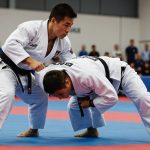Understanding Lactate Threshold
The lactate threshold is a critical concept in endurance sports. It refers to the point during intense exercise at which lactate begins to accumulate in the bloodstream faster than it can be removed. This threshold is pivotal for endurance athletes because it often determines how long and how fast they can sustain an activity without fatigue. Recognising when this buildup occurs, athletes can adjust their pace, maintain higher performance levels, and execute more efficient training sessions.
Physiologically, the body produces lactate continuously, but during strenuous exercise, production speeds up, sometimes overwhelming the body’s ability to clear it. The accumulation predominantly occurs in the muscles and is transported to the bloodstream. This shift leads to increased acidity and results in fatigue. An athlete’s ability to efficiently clear lactate and delay its accumulation dictates their athletic performance.
Additional reading : Elevate your golf performance: the definitive strength training blueprint for hitting longer drives
Understanding and enhancing one’s lactate threshold can significantly impact endurance training, allowing athletes to sustain higher intensities for longer periods. This key element transforms training regimens, potentially increasing overall success in competitions. Emphasizing lactate threshold in workouts aligns with achieving optimal training efficacy and maintaining superior athletic performance levels.
Proven Techniques to Enhance Lactate Threshold
Improving the lactate threshold involves incorporating specific endurance techniques. By doing so, athletes can significantly boost their performance improvement potential.
Also read : Mastering mental imagery: elevate athletic performance during high-stakes moments
High-Intensity Interval Training (HIIT)
HIIT consists of short, intense bursts of exercise followed by rest or low-intensity periods. For example, running at maximum effort for one minute, then walking for two minutes, repeated multiple times. HIIT effectively raises the lactate threshold by pushing the body beyond its comfort zone, encouraging adaptation to higher intensities. When integrated into a regular regimen, HIIT enhances the body’s ability to clear lactate.
Tempo Runs and Sustained Efforts
Tempo runs involve running at a ‘comfortably hard’ pace, just below the lactate threshold. These runs train the body to perform efficiently at a high threshold level. Structured properly, they might include 20-minute sessions at this challenging pace. Regular tempo training ensures endurance athletes can sustain greater efforts over longer distances.
Strength Training for Endurance Athletes
Strength training fortifies muscles, improving threshold training effectiveness. Exercises like squats and lunges, combined with threshold workouts, expand an athlete’s capacity to perform under duress. Enhanced muscle strength directly correlates to more efficient lactate processing during intense activities.
Nutrition Strategies for Enhancing Endurance
When aiming to enhance endurance performance, understanding the right performance nutrition is crucial. Proper nutritional strategies not only boost the lactate threshold but also support efficient recovery and energy supply.
Endurance athletes require personalized macronutrient ratios, typically high in carbohydrates, which provide the necessary fuel for prolonged activities. Proteins aid in muscle recovery and repair, while healthy fats contribute to sustained energy release. To optimise performance, it is essential to consume these nutrients in balanced proportions tailored to individual training intensities and objectives.
Additionally, the timing of nutrient intake can profoundly impact training outcomes. Consuming carbs before workouts powers endurance, while post-exercise protein intake facilitates recovery strategies by promoting muscle repair and growth. Hydration is also pivotal; maintaining fluid balance prevents fatigue and maintains performance levels.
Some supplements may further enhance endurance, such as branched-chain amino acids (BCAAs) for repairing muscle and electrolytes for restoring minerals lost through sweat. Dietary strategies should be adapted to accommodate the specific fueling for endurance needs of each athlete, ensuring they maintain peak performance throughout their training sessions and competitions.
Recovery Methods to Optimize Training
Understanding proper recovery techniques is crucial for athletes striving to maximize their training adaptation and prevent injury. Including well-structured recovery strategies in an endurance regimen can enhance athletic performance and ensure sustainability.
Importance of Recovery in Endurance Training
Recovery plays a vital role in improving the lactate threshold. By facilitating muscle repair, it aids in reducing fatigue and enhances the ability to sustain high performance. Practices such as foam rolling, stretching, and compression therapy can significantly bolster recovery and promote training efficiency.
Active Recovery Techniques
Active recovery introduces moderate physical activity as a recovery method, maintaining fitness levels without overexerting the body. Activities like light cycling or yoga improve blood circulation, expediting the clearance of lactate from muscles. Incorporating active recovery into a weekly schedule ensures consistent endurance training progress.
Sleep and Recovery
Quality sleep is paramount for effective recovery. It enables crucial physiological processes, like muscle growth and repair, directly impacting performance. Improving sleep involves establishing a consistent bedtime routine and a comfortable sleeping environment. Neglecting this essential aspect can negatively affect the lactate threshold and overall performance. By focusing on recovery, athletes can enhance both training outcomes and their endurance capabilities.
Case Studies and Success Stories
Examining athlete case studies provides valuable lessons about endurance improvement. One notable example is a long-distance runner who significantly raised their lactate threshold through structured threshold training. This athlete focused on a comprehensive training plan integrating high-intensity interval training (HIIT) and tempo runs, customised to incrementally increase intensity over weeks. The result was an extended capability to maintain speed without early fatigue.
Another fascinating story comes from a triathlete whose breakthrough came via performance improvement techniques focusing on strength training. By incorporating targeted exercises such as squats and lunges, they enhanced athletic performance by strengthening key muscle groups, facilitating a more efficient lactate clearance process.
Additionally, a cyclist’s success highlights the role of nutrition strategies. By optimising their macronutrient intake—focusing on carbohydrates for sustained energy and proteins for recovery—they maintained peak performance levels in demanding races.
These examples illustrate that tailored approaches greatly enhance endurance improvement. Key takeaways indicate the need for integrated threshold training, nutritional adjustments, and strength training for maximal performance. These insights reinforce the importance of personalised approaches to optimise outcomes.





